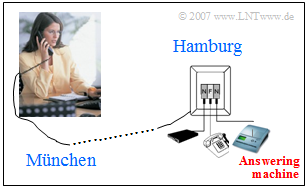Exercise 1.1Z: ISDN Connection
From LNTwww
We consider the scenario shown in the picture:
A woman from Munich dials a number in Hamburg with her ISDN phone. However, she cannot reach the person she wants to talk to, so she leaves him a message on tape.
The distortion-free connection is fully described by
- an attenuation coefficient $\alpha$,
- a term $\tau$ and
- the current signal-to-noise ratio (SNR).
Notes: The task shall establish a relation between this real scenario and the functional units of a general communications system mentioned in the theory section .
Questions
Solution
(1) The first two statements are correct:
- The speech signal ${q(t)}$ must first be converted into an electrical signal and then prepared for transmission.
- For ISDN the transmitted signal ${s(t)}$ is digital.
(2) Correct are the solutions 3 and 4:
- The received signal ${r(t)}$ is always analog due to the unavoidable thermal noise.
- The message sink is the answering machine.
- In an ideal transmission system $v(t) = {q(t)}$ should apply.
- However, due to the additive noise term ${n(t)}$, the attenuation $\alpha$ and the running time $\tau$ the following applies here:
- $$v(t) = \alpha \cdot q ( t - \tau) + n(t).$$
- By our definitions, this is a distortion-free system.
